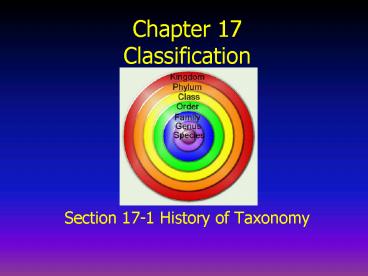Chapter 17 Classification - PowerPoint PPT Presentation
1 / 29
Title:
Chapter 17 Classification
Description:
Taxonomy is the branch of biology that names organisms according to their ... Chordata. Basidiomycota. Chordata. Class. Mammalia. Homobasidio-mycetae. Mammalia. Order ... – PowerPoint PPT presentation
Number of Views:38
Avg rating:3.0/5.0
Title: Chapter 17 Classification
1
Chapter 17Classification
- Section 17-1 History of Taxonomy
2
Taxonomy is the branch of biology that names
organisms according to their characteristics and
evolutionary history
3
Taxonomy organizes the huge biodiversity (variety
of types of life) of the planet
4
- Organisms were first classified by Aristotle over
2000 yrs ago! - His system classified organisms as either plant
or animal. - Problems with his classification
- Some organisms are neither plant or animal
- Common names are different in different regions
(ex. Puma, cougar, and mountain lion are all same
animal - Some common names are
- inaccurate (ex. Jellyfish is not a
- fish, seahorse is not a horse)
5
Carolus Linnaeus developed a more organized
system of classification in the 1700s
- This system involves seven levels of
classification which are still used today
6
Levels of classification
- Memory device
- King
- Phillip
- Came
- Over
- For
- Good
- Spices
- Kingdom
- Phylum
- Class
- Order
- Family
- Genus
- Species
7
Some examples (pg. 338)
8
Some examples (pg. 338)
9
Linnaeuss system for naming
- The system is known as binomial nomenclature (bi-
means 2) - Each species is identified by two names genus
and species. - Genus is capitalized the species is not and both
are written in italics - Ex Lynx rufus and Homo sapiens
10
(No Transcript)
11
Section 17-2 Modern Phylogenetic Taxonomy
12
- Classification originally based on morphology
- Modern taxonomists use this and other evidence to
place organisms on a phylogenetic tree - A phylogenetic tree is a diagram showing
evolutionary relationships of organisms
13
(No Transcript)
14
(No Transcript)
15
4 Types of Evidence Help Scientists make a
Phylogenetic Tree
16
Evidence
- Morphology, or the appearance of an organism.
Related organisms will share homologous
structures
17
Evidence
- 2. The fossil record
- Some fossils serve as links in connecting
current groups of organisms. - EX archaeopteryx
18
Evidence
- 3. Embryological patterns of development
- By looking at the stages of an organisms
development scientists can see patterns. - Ex all fertilized animal eggs begin to grow in
the same way - Zygote ? blastula ? gastrula (read pg 344)
19
Evidence
- Comparing the number of differences in DNA, amino
acids and proteins - If mutations in sequence occur regularly
scientists can predict how closely related
organisms are. The more similar the DNA the more
closely related the species.
20
Cladistics
- A new system of phylogenetic classification.
- It uses a shared derived characteristic to
establish relationships - Ex amniotic (shelled) egg separates reptiles and
birds from other organisms or hair on mammal
21
How to read a cladogram
Everything else has jaws
No jaws
22
Section 17-3 Two Modern Systems of Classification
23
Two main systemsThree Domain and Six Kingdom
24
Kingdom Archeabacteria
- Unicellular (one-celled)
- Prokaryotic (no nucleus)
- Chemosynthetic (use
- carbon chemicals to make energy)
- They have different cell membranes than other
organisms - They often live in harsh environments
25
Kingdom Eubacteria
- Unicellular
- Prokaryotic
- Most use oxygen for
- respiration
- These are true bacteria involved in decomposing
dead animals and plants, making yogurt, etc.
26
Kingdom Protista
- Unicellular
- Eukaryotic (has nucleus)
- Can be autotrophic (make food or heterotrophic
(eat food) - Although in the same kingdom there is a huge
variety all very distantly related
Ex amoeba and euglena
27
Kingdom Fungi
- Multicellular AND UNICELLULAR! oops
- Eukaryotic
- They are heterotrophic (eat food) specifically
they absorb food. - Common fungi Yeast mushrooms
28
Kingdom Plantae
- Multicellular
- Eukaryotic
- Autotrophic - Plants use solar energy to
photosynthesize or make food - Most plants live on land and reproduce sexually
- Ex venus fly trap oak tree
29
Kingdom animalia
- Multicellular
- Eukaryotic
- Heterotrophic (eat food)
- Can live on land or water.
- Reproduce sexually
- Ex. Coral elephant































